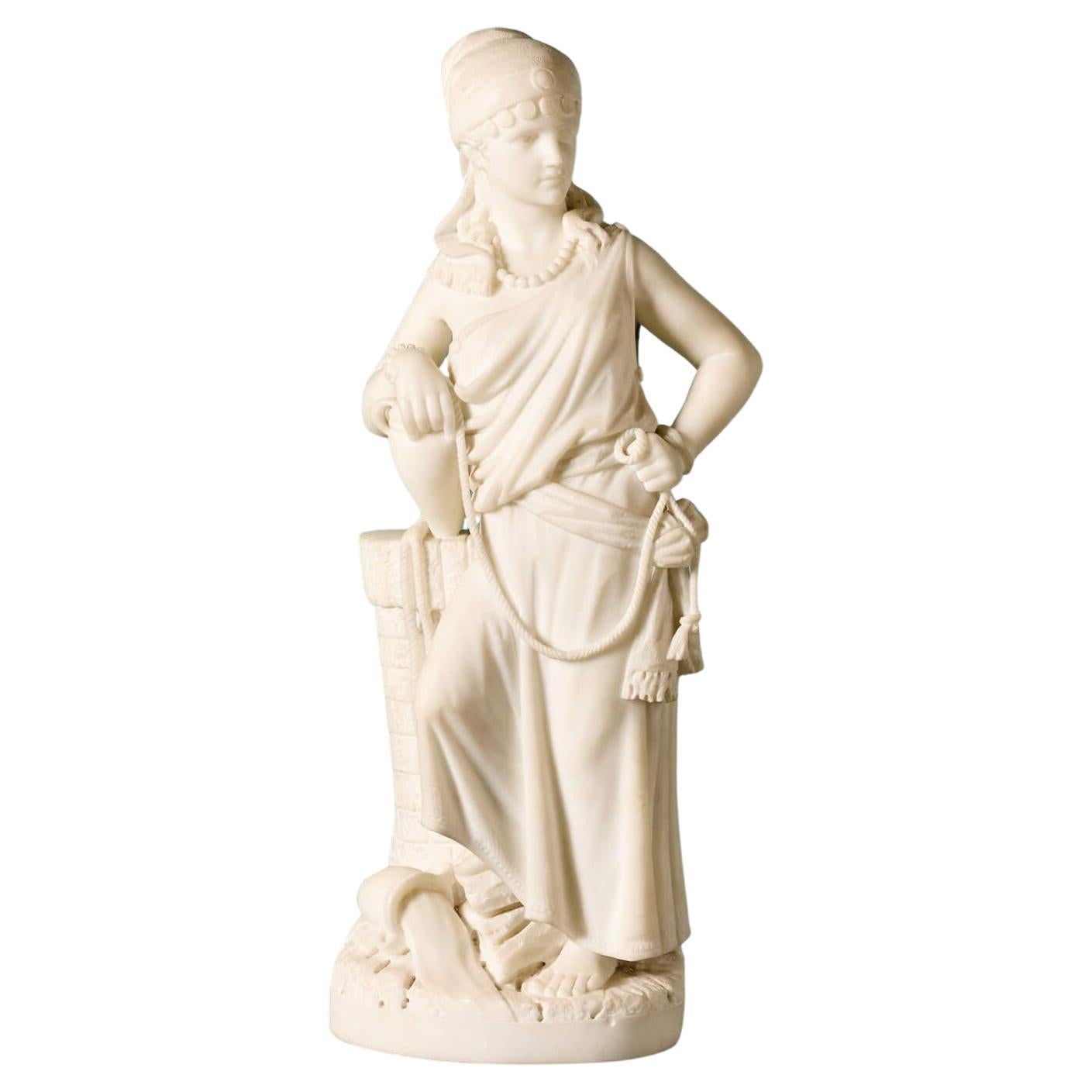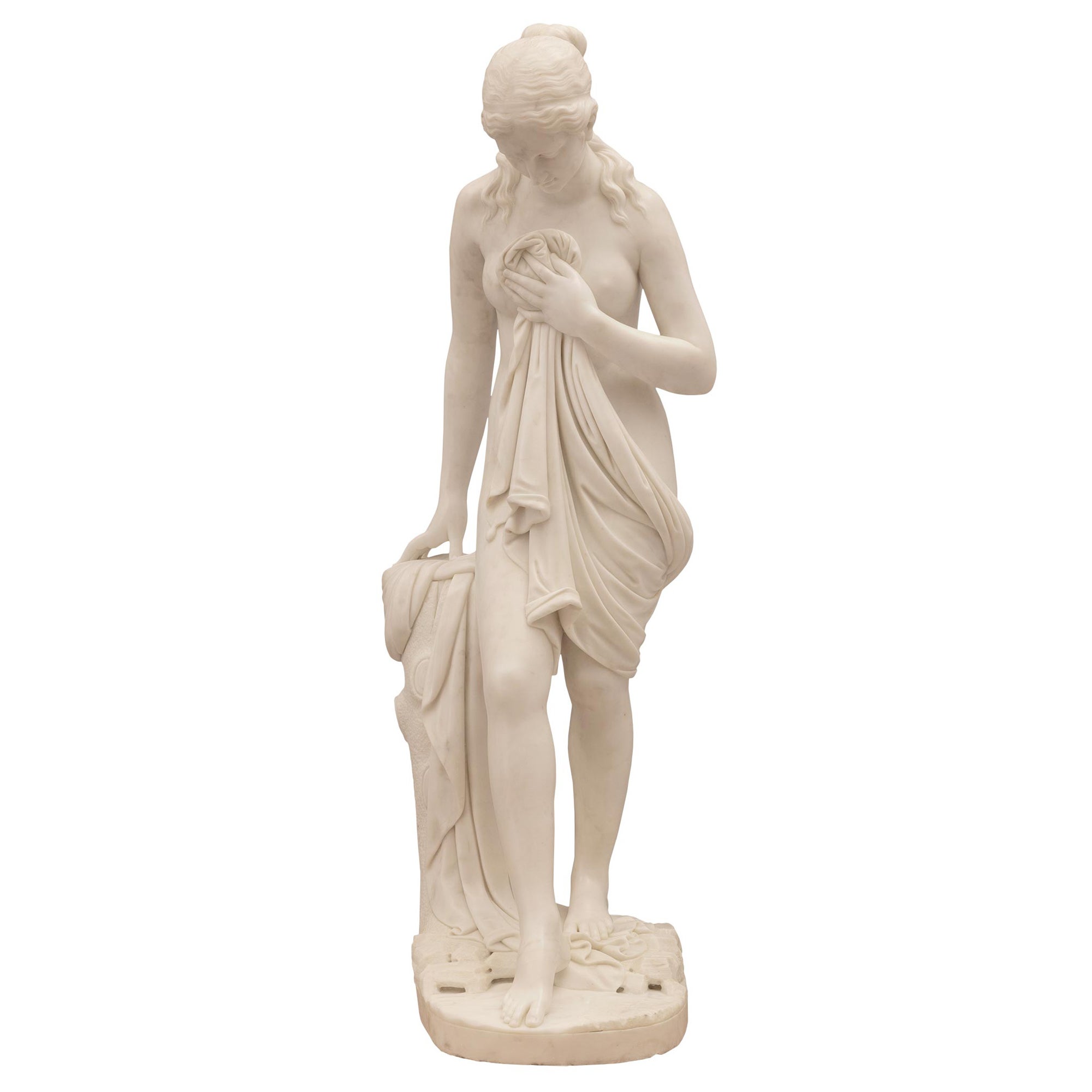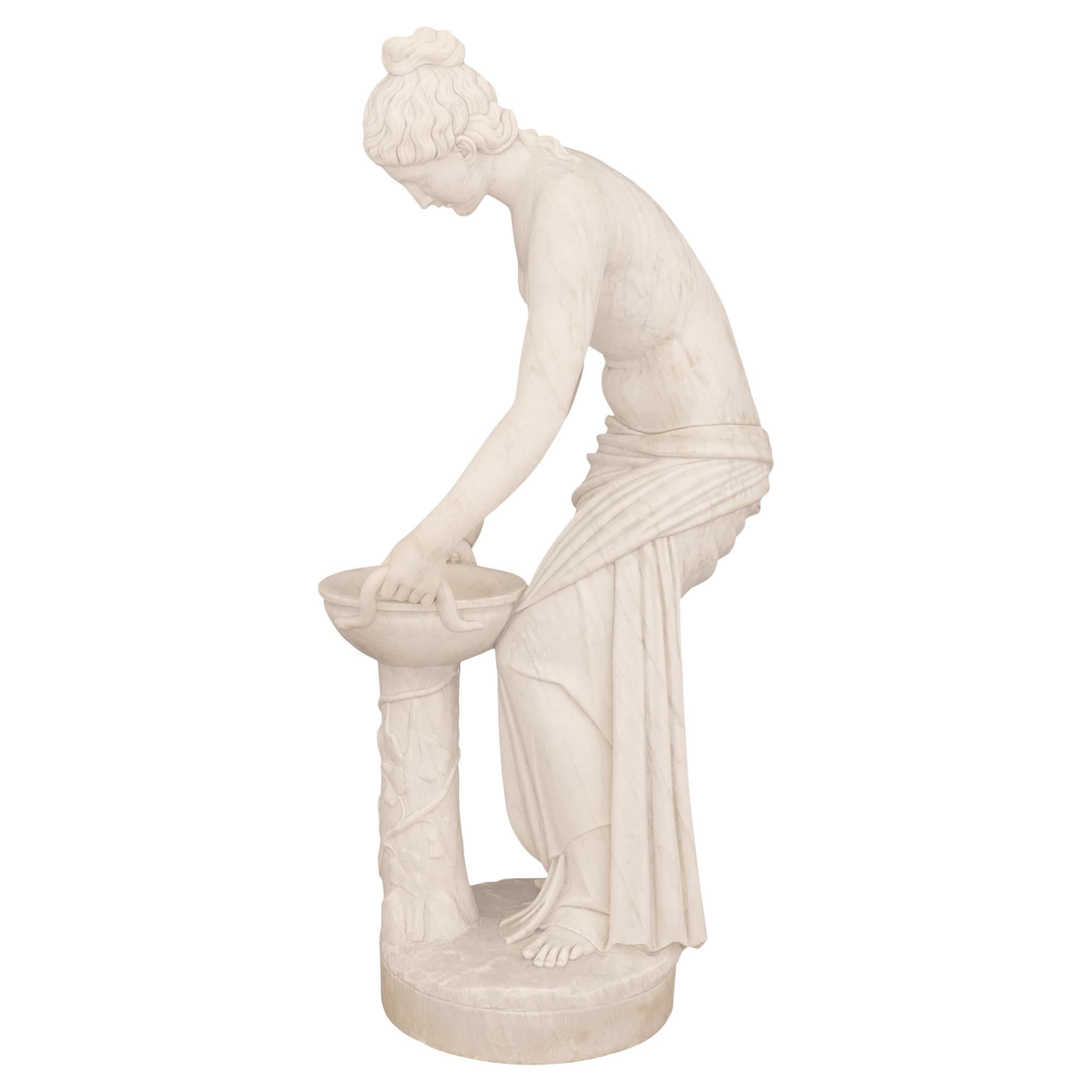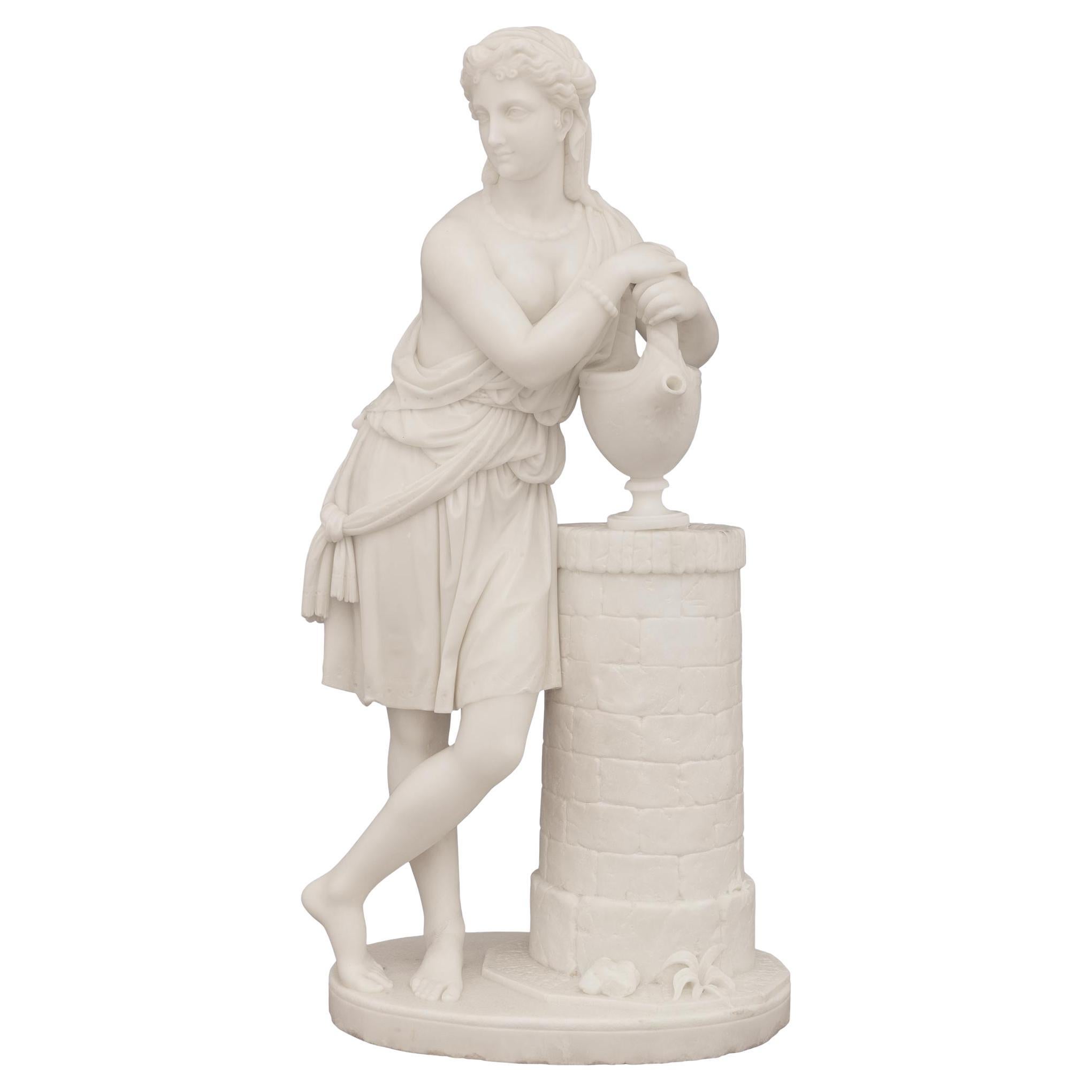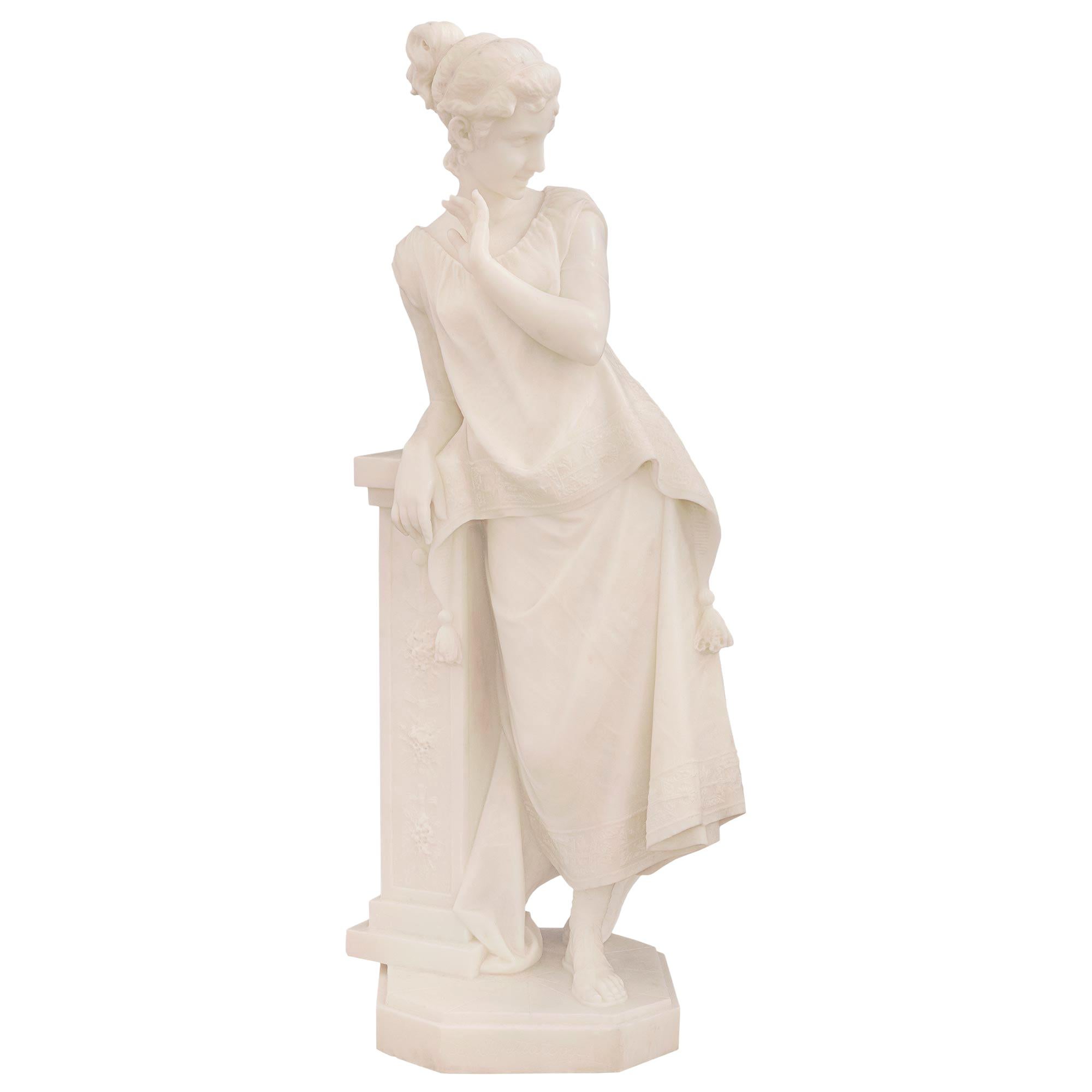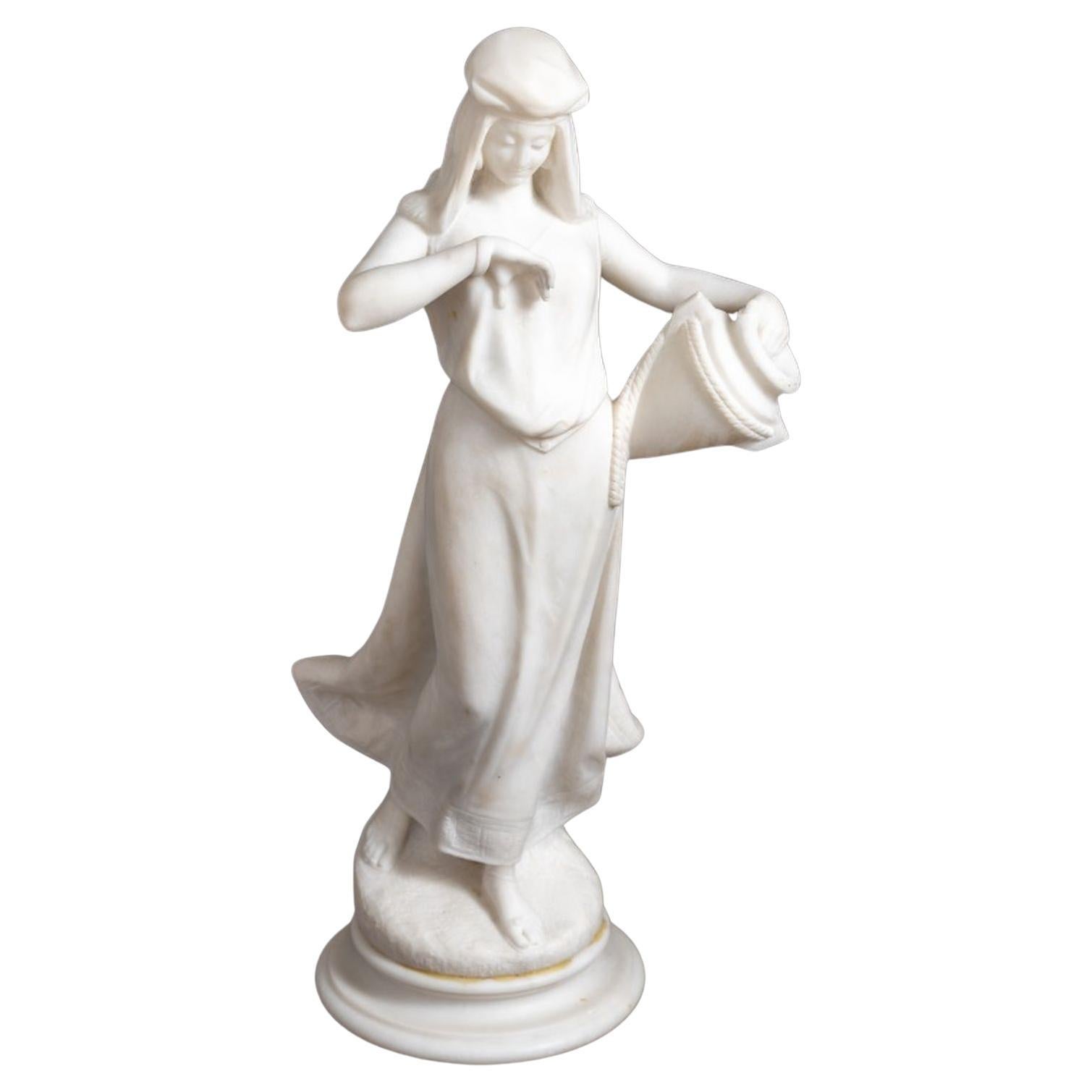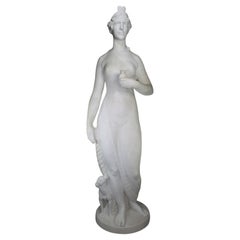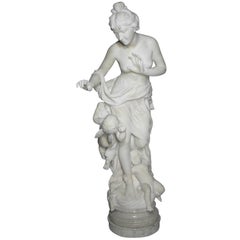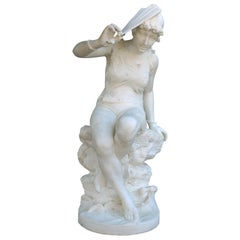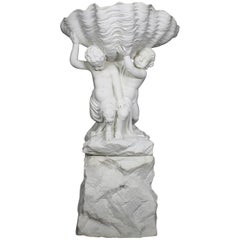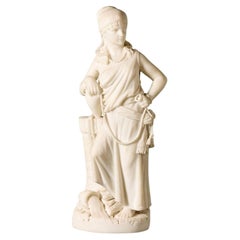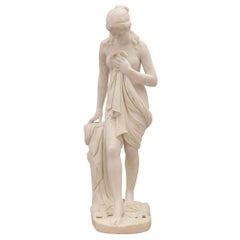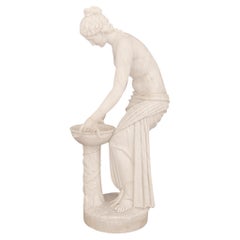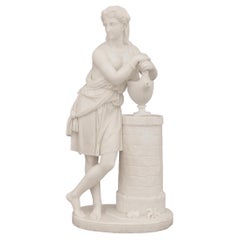Items Similar to Fine 19th Century White Marble Sculpture of “Rebecca at the Well”
Video Loading
Want more images or videos?
Request additional images or videos from the seller
1 of 22
Fine 19th Century White Marble Sculpture of “Rebecca at the Well”
$14,850
$34,85057% Off
£11,200.74
£26,285.9057% Off
€12,936.96
€30,360.4857% Off
CA$20,805.87
CA$48,827.2557% Off
A$23,134.94
A$54,293.1057% Off
CHF 12,111.56
CHF 28,423.4257% Off
MX$282,597.58
MX$663,200.3857% Off
NOK 152,193.65
NOK 357,168.2657% Off
SEK 143,168.63
SEK 335,988.3257% Off
DKK 96,573.53
DKK 226,638.8957% Off
About the Item
A Fine 19th century white marble sculpture of “Rebecca at The Well” depicting a Classical maiden wearing a robe, with one breast semi-exposed, standing next to a well holding a water urn. Probably Italian Carrara Marble. Artist unknown. Circa: 1880-1890.
Measures: Height 40 3/4 inches (103.5 cm)
Width 20 inches (50.8 cm)
Depth: 13 1/2 inches (34.3 cm)
Biblical References:
Rebecca appears in the Hebrew Bible as the wife of Isaac and the mother of Jacob and Esau. According to biblical tradition, Rebecca's father was Bethuel the Aramean from Paddan Aram, also called Aram-Naharaim. Rebecca's brother was Laban the Aramean, and she was the granddaughter of Milcah and Nahor, the brother of Abraham. Rebecca and Isaac were one of the four couples that some believe are buried in the Cave of the Patriarchs, the other three being Adam and Eve, Abraham and Sarah, and Jacob and Leah.
After the Binding of Isaac, Sarah died. After taking care of her burial, Abraham went about finding a wife for his son Isaac, who was already 37 years old. He commanded his servant (whom the Torah commentators identify as Eliezer of Damascus) to journey to his birthplace of Aram Naharaim to select a bride from his own family, rather than engage Isaac to a local Canaanite girl. Abraham sent along expensive jewelry, clothing and dainties as gifts to the bride and her family. If the girl had refused to follow him, Abraham stated that Eliezer would be absolved of his responsibility.
The servant devised a test in order to find the right wife for Isaac. As he stood at the central well in Abraham's birthplace with his men and ten camels laden with goods, he prayed to God:
'And let it come to pass, that the damsel to whom I shall say, Let down thy pitcher, I pray thee, that I may drink; and she shall say, Drink, and I will give thy camels drink also: let the same be she that thou hast appointed for thy servant Isaac; and thereby shall I know that thou hast shewed kindness unto my master.'
— Genesis 24:14
To his surprise, a young girl immediately came out and offered to draw water for him to drink, as well as water to fill the troughs for all his camels. Rebecca continued to draw water until all the camels were sated, proving her kind and generous nature and her suitability for entering Abraham's household.
The servant immediately gave her a golden nose ring and two golden bracelets (Genesis 24:22), which Rebecca hurried to show her mother. Seeing the jewelry, Rebecca's brother Laban ran out to greet the guest and bring him inside. The servant recounted the oath he made to Abraham and all the details of his trip to and meeting with Rebecca in fine detail, after which her brother Laban and her father Bethuel agreed that she could return with him. After hosting the party overnight, however, the family tried to keep Rebecca with them longer. The servant insisted that they ask the girl herself, and she agreed to go immediately. Her family sent her off with her nurse, Deborah (according to Rashi), and blessed her, "Our sister, may you come to be thousands of myriads, and may your offspring inherit the gate of its foes."
Rebecca at the Well by Giovanni Antonio Pellegrini
As Rebecca and her entourage approached Abraham's home, they spied Isaac from a distance in the fields of Beer-lahai-roi. The Talmud and the Midrash explain that Isaac was praying, as he instituted Mincha, the afternoon prayer. Seeing such a spiritually exalted man, Rebecca immediately dismounted from her camel and asked the accompanying servant who he was. When she heard that this was her future husband, she modestly covered herself with a veil. Isaac brought her into the tent of his deceased mother Sarah, married her, and loved her.
According to Rashi, the three miracles that characterized Sarah's tent while she was alive, and that disappeared with her death, reappeared when Rebecca entered the tent. These were: A lamp burned in her tent from Shabbat eve to Shabbat eve, there was a blessing in her dough, and a cloud hovered over her tent (symbolizing the Divine Presence).
- Dimensions:Height: 40.75 in (103.51 cm)Width: 20 in (50.8 cm)Depth: 13.5 in (34.29 cm)
- Style:Neoclassical (In the Style Of)
- Materials and Techniques:
- Place of Origin:
- Period:
- Date of Manufacture:circa 1880-1890
- Condition:Additions or alterations made to the original: The base of the sculpture bears the inscription 'Edmonia Lewis', however we do not believe nor represent that this sculpture is by Lewis, as we believe the inscription is spurious and was added later. This is most likely an Italian sculpture. Repaired: Some restorations to the rope by the well and touch-ups. Wear consistent with age and use. Minor fading. A beautiful sculpture. Some weathering and restorations to the rope. The base has some discoloring, probably due to water exposure. Please view all images and disclosures.
- Seller Location:Los Angeles, CA
- Reference Number:Seller: Ref.: A2037 - Lot 111071stDibs: LU1796228020902
About the Seller
5.0
Vetted Professional Seller
Every seller passes strict standards for authenticity and reliability
Established in 1982
1stDibs seller since 2016
135 sales on 1stDibs
Typical response time: 1 hour
- ShippingRetrieving quote...Shipping from: Los Angeles, CA
- Return Policy
Authenticity Guarantee
In the unlikely event there’s an issue with an item’s authenticity, contact us within 1 year for a full refund. DetailsMoney-Back Guarantee
If your item is not as described, is damaged in transit, or does not arrive, contact us within 7 days for a full refund. Details24-Hour Cancellation
You have a 24-hour grace period in which to reconsider your purchase, with no questions asked.Vetted Professional Sellers
Our world-class sellers must adhere to strict standards for service and quality, maintaining the integrity of our listings.Price-Match Guarantee
If you find that a seller listed the same item for a lower price elsewhere, we’ll match it.Trusted Global Delivery
Our best-in-class carrier network provides specialized shipping options worldwide, including custom delivery.More From This Seller
View AllEnglish Life-Size Neoclassical Revival Style White Marble Nude Maiden with Dog
Located in Los Angeles, CA
A Very Fine English Life-Size Neoclassical Revival Style White Marble Group of a Standing "Fisher Girl with a Dog", the tall and slender sculpture depicting a standing scantily clad nude maiden wrapped in a fishing net, wearing nothing but a tiara...
Category
Early 20th Century English Neoclassical Revival Figurative Sculptures
Materials
Marble
$19,850 Sale Price
53% Off
Italian 19th-20th Century Life-Size Marble Sculpture Titled "Searching for Love"
By Vito Pardo
Located in Los Angeles, CA
A very fine museum quality Italian 19th-20th century life-size marble sculpture titled "Searching for Love" by Vito Pardo (Italian, born in Venice in 1872) Depicting a semi-nude life...
Category
Antique Early 1900s Italian Rococo Figurative Sculptures
Materials
Marble, Bronze
$219,600 Sale Price / set
44% Off
Italian Late 19th Century Belle Epoque Carved Marble Figure of a Bather Girl
Located in Los Angeles, CA
A fine Italian late 19th century "Belle Époque" carved marble figure of a young bather. The seated young girl wearing a form-fitting one-piece tank suit, holding a hand fan, and seat...
Category
Antique Early 1900s Italian Belle Époque Figurative Sculptures
Materials
Marble
$22,850 Sale Price
46% Off
Italian 19th Century Carved Carrara Marble Figural Fountain Jardinière Planter
By Giovanni Battista Lombardi
Located in Los Angeles, CA
A very fine Italian 19th century carved Carrara marble figural fountain "Jardinière" modelled as a standing Putto and a Satyr supporting a sea-sh...
Category
Antique 19th Century Italian Baroque Figurative Sculptures
Materials
Carrara Marble
$28,950 Sale Price
35% Off
Italian 19th Century Carrara Marble Sculpture Going for a Swim by Emilio Fiaschi
By Emilio Fiaschi
Located in Los Angeles, CA
A very fine Italian 19th century Carrara marble sculpture depicting a young beauty going for a Swim standing on the steps of a dock, raised on its ori...
Category
Antique Late 19th Century Italian Belle Époque Figurative Sculptures
Materials
Marble
Italian 19th-20th Century Whimsical White Marble Wishing Wellhead with Children
Located in Los Angeles, CA
A very fine and exceptionally carved Italian 19th-20th century Baroque Revival style whimsical white Carrara marble wishing wellhead, raised on an octagonal two-step marble base. The intricately carved marble relief circular wellhead depicting carved figures of dancing and cheerful children (Putti) among vines, flowers and fruits, dancing and playing musical instruments with a backdrop of castles, landscapes, forests and wreaths, Florence, circa, 1900.
Note: We have part II video of this amazing Wishing Wellhead. Please feel free to request a copy.
Literature:
A similar wellhead was sold by Jan's & Co. Fine French Antiques, Inc. in 1999, provenance the Atkinson/Kirkeby Estate and it is illustrated in "The Estates of Beverly Hills" by Charles Lockwood and Jeff-Hyland, page 150.
Another similar is currently on display at the gardens of "The Elms" mansion a public museum part of the Newport Mansions by The Preservation Society of Newport County in Newport, Rhode Island.
Yet another similar wellhead carved with frolicking putti with musical instruments and a dentil molded rim is located at Cranbrook House, Bloomfield Hills, Michigan, and is illustrated in B. Israel, Antique Garden Ornament...
Category
Antique Early 1900s Italian Baroque Revival Figurative Sculptures
Materials
Carrara Marble
You May Also Like
Neoclassical Marble Statue of Rebecca at the Well
Located in Wormelow, Herefordshire
An antique Neoclassical statuary marble statue of Rebecca at the well, signed and dated 'ABO CIPRIANI FECE 1880', from a private collection in London.
Dating to circa 1880, this expe...
Category
Antique Late 19th Century English Grand Tour Statues
Materials
Marble, Statuary Marble
Italian 19th Century White Carrara Marble Statue of a Beautiful Bathing Woman
Located in West Palm Beach, FL
A stunning and extremely high quality Italian 19th century white Carrara marble statue of a beautiful bathing woman. The statue is raised by a ground designed base where the richly s...
Category
Antique 19th Century Italian Figurative Sculptures
Materials
Marble
Italian 19th century white Carrara marble statue of Hebe
Located in West Palm Beach, FL
A stunning and finely detailed Italian 19th century white Carrara marble statue of Hebe. This stunning statue depicts Hebe, the goddess of youth and the daughter of Zeus and Hera. He...
Category
Antique 19th Century Italian Figurative Sculptures
Materials
Marble
An Italian early 19th century marble statue by Carmelo Fontana
Located in West Palm Beach, FL
A spectacular and highly detailed Italian early 19th century white Carrara marble statue of Rebecca at the well, signed by Carmelo Fontana (1775-1825). Rebecca is standing pro...
Category
Antique Early 19th Century Italian Figurative Sculptures
Materials
Carrara Marble
Italian 19th Century White Carrara Marble Statue of a Beautiful Maiden
By Ferdinando Vichi
Located in West Palm Beach, FL
An exceptional Italian 19th century white Carrara marble statue of a beautiful maiden, signed F. Vichi. The statue is raised by a fine octagonal base with a decorative mottled border...
Category
Antique 19th Century Italian Figurative Sculptures
Materials
Carrara Marble
"The Water Carrier" White Marble Sculpture
Located in Astoria, NY
"The Water Carrier" White Marble Sculpture, depicting a standing figure holding a water vessel, on a socle. 22" H x 7" W x 7" D.
Category
Early 20th Century Neoclassical Figurative Sculptures
Materials
Marble
More Ways To Browse
Antique Well Cover
Expensive Jewelry
Breast Sculpture
Italian Hand Carved White Marble Sculpture
Adam Brothers
Girl Lamp
Circa 1890 Bracelets
Water Maiden
Hand Carved Camel
Antique Mothers Ring
Antique Nurses
Antique Torah
Antique Family Bible
Damascus Furniture
Couple Love Sculptures
Camel Lamp
Antique Damascus
Family Bible
